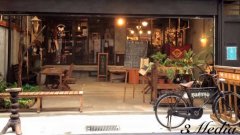The third wave of boutique coffee: why do young people just want to open a coffee shop when they are obviously not making money?

For professional baristas, please follow the coffee workshop (Wechat official account cafe_style)
Do you have a coffee dream?
Many people know that opening a cafe can't make a lot of money, but is it still what young people want most to make a lot of money? Some wonderful answers to this question began to appear in the new generation, from the previous generation working hard to make money, slowly turning into earning a good life, opening a cafe to support themselves, and mastering their own rich life in time and space. Today's cafes no longer sell a cup of coffee, but also sell a "life aesthetic attitude."
17-1 (Photo: Blue Bottle)
The most famous example is the Blue bottle Coffee (Blue Bottle), which started in San Francisco in the United States. Blue bottle, with its high-quality single-producing area coffee, meticulous hand-brewing and ice-drop making, transforms the romance of past coffee roasting enthusiasts or independent cafes into a brand-new life brand; and brings simplicity and warmth into the all-coffee atmosphere space to provide beauty for prosperous cities. To drive the third wave of the coffee revolution.
Reviewing the three waves of Coffee Revolution: from Fast Food to Life Aesthetics
If you look at the history of coffee, you will be surprised to find that Taiwan has deep ties with the United States and Europe, and now the third wave of coffee revolution in the world is also beginning to converge. In his book "Fine Coffee Science," Mr. Han Huaizong gives a detailed introduction to the three waves of coffee revolution in the United States and Europe:
73436762 (Photo: coffeegenes)
The first wave (1940 MFLMI 1960): fast-eating coffee
Before and after World War II, instant coffee (and Robasta beans) prevailed, but its poor quality led to the elimination of coffee, and in order to reduce costs, it made more extensive use of shoddy coffee beans, resulting in a quantity and quality of coffee fast food culture. Drinking coffee usually produces side effects such as palpitations, which are caused by shoddy coffee beans.
The second wave (1966 murmur2000): coffee boutique
The "second wave" after 1966, American Alfred Peet created Peet's Coffee & Tea coffee and tea, promoting European re-baking and fresh brewing, using 100% high-altitude Arabica beans to enhance the flavor.
Starbucks, the apprentice of Bitz Coffee, introduced Italian cappuccino and latte and packaged it into a fashionable drink. Open a chain of cafes to launch the "second wave" of boutique coffee after globalization.
The third wave (2003 music-so far): coffee aestheticization
The "third wave of coffee" comes from a group of skilled Norwegian baristas fighting with the Swiss company Nestle to invent a fully automatic coffee machine.
There are three famous third wave cafes in the United States: intellectual Coffee and Tea (Intelligentsia Coffee & Tea), Shudun City Coffee Bakery (Stumptown Coffee Roasters) and counter-Cultural Coffee (CounterCulture Coffee).
The common people who innovate to counter the second wave of "coffee oligarch Starbucks" include: using single-farm coffee beans, shallow roasting to find out the advantages of beans, and moving consumers through a series of professional coffee brewing processes by baristas. and learn more about the style of coffee beans and the taste of coffee.
The third space: the cafe is the place where the city's imagination is stirring.
Did Sex and the City (Sex and the City), which began in 1998? Kelly, the heroine in the play, writes a column in a cafe with a laptop. She tells the hero what time of the week he talks in a cafe around the corner, showing the metropolis of New York. A small cafe occupies a place in the hearts of all kinds of men and women.
In 1989, Ray Oldenburg, an American sociologist, put forward the term "The third place" in "The Great Good Place": the space where people spend the most time and activity outside their home (first) and workplace (second), such as cafes. During the French Revolution, the cafe was the place with the most abundant social power and imagination of intellectuals.
Cafes have become the most important space for communication between urban families and outside work.
Japanese writer Taro Kawamoto, 70, made it clear: "the size of a city is inversely proportional to the personal living space. The smaller the home is, the bigger the city is and the more developed it is."
As a result, walking into the cafe is not only for a cup of coffee, but also for the short-term "self-possession" meaning of life.
1010244_4953546850708_1990689865_n
(photo Source: the third Media-Star Cafe)
The coffee revival that has sprung up from Taiwan's alleys in recent years has a strong third wave of coffee cultural significance, just like the star cafe in the past. Zhou Mengdee set up a small bookstall in the arcade of the cafe, attracting cultural people to gather, and it has become a moving Taipei literary legend for 21 years.
Coffee is the presentation of the life attitude of the new generation.
When the owner of Debu Coffee, a coffee shop in Taipei's Zhongshan District, described himself as "changing the pace of life" when he started a cafe. Coffee highlights the "free and romantic" life of the new generation, while the focus on raw beans, roasting, brewing and so on is only to produce a cup of perfect coffee.
In line with the appearance of a new generation of diversified entrepreneurs, small cafes are leisurely in books, writing punch cards, playing desserts, taking care of children, and even combining organic farms like happy farms to make healthy and minimalist cuisine.
In addition to being a cafe owner, you can also play different roles such as writers, cooks, painters, and so on. The new generation of people who open small cafes need not only money, but also pure elegance and leisure. What they want to earn is: "their own life." be a romantic, real, free person.
For consumers, every consumption is a presentation of their own value: for companies, we can choose companies that are more willing to assume social responsibility, and the third wave of coffee revolution is not just about cups of coffee and oligarch Starbucks.
But the concept of the new generation's pursuit of a better life, and a primitive desire for life. The third wave of coffee revolution crashed into a "beautiful attitude towards life". Because of the third wave of the Coffee Revolution, what we drink is to try to live a good life.
To you who have a coffee dream or who are practicing:
If you are a coffee shop owner or have a dream that is brewing, we are happy to assist in reporting or more possible cooperation. We are also welcome to help those of us who are putting it into practice. Let's start the third wave of coffee revolution in Taiwan.
Important Notice :
前街咖啡 FrontStreet Coffee has moved to new addredd:
FrontStreet Coffee Address: 315,Donghua East Road,GuangZhou
Tel:020 38364473
- Prev

In pursuit of a better life, do you have to drink bitter and astringent coffee?
Exchange of professional baristas Please follow the coffee workshop (official Wechat account cafe_style). No matter how busy it is in 1996, I would like to have a cup of coffee with you. At that time, Nestle instant coffee gave us a reason to steal free time in our busy life. In 2011, the unified superstore invited actor Guilun magnesium to shoot a series of advertisements for my cafe all over the city, which made us more accustomed to everywhere.
- Next

Boss, what is "roast handmade black sugar coffee latte"-- a special kind of firm
The exchange of professional baristas Please follow the coffee workshop (Wechat official account cafe_style) many guests looking at the handmade brown sugar coffee latte on menu, there is always a question, what is roasted handmade brown sugar? Let the editor solve the confusion for you. 117221481103872989809484669422458815887800Oo this kind of coffee is made by hand-cooked black in Guanshan, Tainan.
Related
- Is espresso stored overnight in the refrigerator harmful to your body? Is frozen coffee better than freshly ground coffee?
- What parameters and proportions of water temperature should be used to grind and brew fresh coffee beans? Why can't I drink freshly roasted coffee right away?
- Customers have "changed" Manner's new products! Shop assistant: Please don't mess around!
- Remove sockets in customer areas at Starbucks stores?! Netizen: I won't go if I really tear it down
- What is the difference between the taste steps of sun-dried coffee and washed coffee? Why is sun-cured coffee sweeter and washed coffee sour?
- The recipe for salty grapefruit dirty is revealed! Coffee Festival salty grapefruit dirty coffee making materials parameters ratio milk share!
- How about the flavor of Sunlight 74158 at Sidamo Banshaha Mathieu Processing Factory in Ethiopia? 74158 Share the proportion of coffee brewing parameters!
- What effect does Italian American coffee with filter paper have? Will coffee taste better if it is put on filter paper at the bottom of the powder bowl?
- What is the color difference in coffee beans? What are the characteristics of honey processed coffee beans? Why are the anaerobically treated coffee beans uneven in color?
- How does novice Xiaobai quickly get started and make coffee? Newbies learn to make coffee by hand and share the specific steps and process process!

